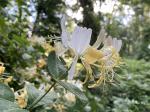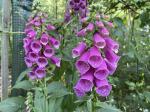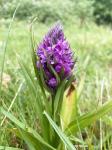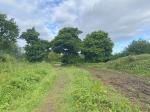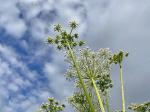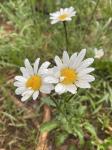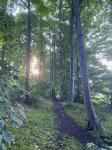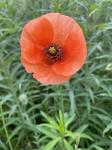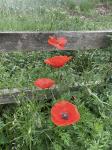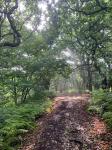Brayton Barff Through the Seasons.
Set in the Vale of York, South West of the market town of Selby and between the villages of Thorpe Willoughby and Brayton, lies Brayton Barff, a sandstone Hill approximately one hundred and fifty feet in height which was formed by glacial movement during the last Ice Age. It is a significant landmark in an otherwise flat landscape.
Today the site is primarily owned by Yorkshire Water with Selby District Council owning a small patch of the land adjacent to the A63 Selby bypass. A large underground reservoir occupies the centre of the site which delivers water to around 4.7 million customers throughout Yorkshire.
Within the Barff woodland over 40% of the trees are Sessile Oak which are generally found in semi natural woodlands in the north of the country. These trees are so called because its acorns are not held on stalks, like those of the English Oak (Pedunculate), but attached directly to the outer twigs. There are also several English Oak trees as well as some cross-hybrid oaks. These trees are known to support many species of flora and fauna, invertebrates, mosses, lichen and fungi.
During the Victorian times it is thought that the shipbuilders on the east coast would come over to the Barff for selected cuts of timber to build their sea going vessels.
The Barff also has a variety of other trees including Silver Birch, Beech, Sycamore, Holly, Rowan, Scots Pine, Alder, Hawthorne and European Larch. There are also several Yew, Willow, Hazel, Horse Chestnut and Wych Elm. As with similar woodlands there are a variety of bushes, including Honeysuckle, Elderberry, Gorse, Broom and Buddleia.
The history of Brayton Barff is quite vague, apparently during 1803 a beacon was lit on the Barff when the country was threatened with an invasion by Napoleon. In May 1935, to celebrate King George V's Silver Jubilee, a Bonfire was lit on the Barff as part of the celebrations.
Early issues of Ordnance Survey Maps dated 1903 clearly show a rifle range on the Barff, extending out to Mill Lane. During the 
Between 2001 – 2004 the A63 Selby bypass, 10km twin lane single carriageway was constructed which severed the South West corner of the Barff, adjacent to Selby Golf Course and resulted in a slight redesign of several holes on the golf course. Wooden fencing was erected as a result of this new road running alongside of the Barff and a footbridge constructed over the ‘new road’ following the line of the Bridal way which extends from Mill Lane. Around 2005/2006 a definite 2metre wide limestone aggregate footpath was laid forming a circular path around the outer edges of the woodland. This footpath is approximately 1.2 miles in length and takes about 30 minutes to circumnavigate at a leisurely pace.
In 2012 the Barff was declared an Ancient Oak Woodland and as such throughout 2012 and 2013 significant work had been carried out by the relevant agencies to cut and remove large swathes of non-native trees, creating at that time huge scars on the landscape. Some three years later the planting of the native trees have become well established and are flourishing. Ongoing maintenance work on the footpath around the bottom of the Barff was completed during the Summer of 2016.
A second phase of woodland maintenance commenced during the Autumn of 2019 with the removal of many old and diseased trees and the cutting back of the Gorse and Broom bushes, especially adjacent to the ‘bypass trail’, this work continued through till March 2020 with re planting continuing into April 2020.
Brayton Barff is a popular site for walkers and bird watchers alike and a path circling the outer perimeter of the Barff makes a pleasant thirty minute walk, giving views looking over towards Selby and the village of Brayton as well as the power stations of Drax and Eggborough..jpg)
For the early risers it is a great place to see some stunning sunrises over the villages of Brayton looking towards Drax Power Station, the same with the Sunsets looking over towards Eggborough and Monk Fryston.
The Barff changes with the Seasons and every visit can reveal something new, the woodland is a haven for wildlife. Records show that since 1982 one hundred and twelve species of bird have been seen in the woodland and at least 40 of those have bred here, including Tawny Owl, Buzzard, Green Woodpecker, Spotted Flycatcher, Goldcrest and Nuthatch to name just a few. On average over 70 species of bird are recorded each year. Further details of the bird life on the Barff can be found on the Brayton Barff Group Facebook page, especially the posts from Derek Cooper. Today ‘The Friends of Brayton Barff group’ led by Derek and a small team of volunteers help keep and maintain the cleanliness of the site as well as recording the wildlife and bird sightings.
The Barff is also home to fifteen different species of mammals, including Muntjac Deer, Pipistrelle Bat, Fox, and Field Vole.
Over eighty species of plant and wildflowers have been recorded, included Bee Orchid, Northern Marsh Orchid, Wood Anemone, Marsh Ragwort, Bluebell, White Bluebell, Bittersweet and Purple and White Foxgloves. Over twenty species of Butterfly have been recorded, including Marbled White, Brown Angus, Speckled Wood, Comma and Brimstone.
During the Autumnal months fungi thrives in this woodland environment, species including Fly Agaric, Beefsteak Tree Fungi, Chicken of the Wood, Sulphur Tufts, Stinkhorn, Ink cap, Puffballs and Hoof Bracket are just some of the many varieties that can be found here.
Click on the galleries shown below to expand the albums.
June 2020
The Corona Pandemic continues unfortunately, some of the initial restrictions are being slowly lifted though social distancing at 2metres remains in place.
The sunny and warm weather at the end of May continued for just a few more days into June, but by the 3rd it was a sudden and distant memory with heavy rain all day, unfortunately one consequence to this was that Meggie got ‘cold tail’ from being out in all the rain whilst on her dog walk. The wet weather continued on and off for the following week with both Meg & Gracie wearing their waterproof jackets. It took four days before Meggie’s tail resumed its usual shape and she is now back to normal. By the middle of the month it started to get a little warmer and our morning walks were quite humid with the temperature reaching between 14C – 18C. On Thursday 25th the temperature at 6.30am as I arrived on the Barff was a crazy 18C! by mid afternoon it was 25C. The following day was much the same, 16C and very humid at around 6.00am and later that day rose to 28C with a humidity of 60%, needless to say that evening we had some heavy thundery showers, the rain continued on and off for the rest of the month along with some fresh windy days.
One of the many highlights on the Barff this month was that the Marsh Orchid which came into flower, I spotted it around the beginning of the month and it has stayed in flower for a good three weeks. The Honeysuckle was another highlight, with its beautiful, white and yellow florets making quite a picture, the aroma, especially around the top of Tap Hill was strong and filled the surrounding area, especially on the warm humid mornings when there was little or no wind. The Foxgloves have been huge this month, some reaching 6 ft in height, the bees love them, I often watched the bees as they flew into the long purple coloured trumpets and flit from one to the other until heavily laden with pollen. Ox Eye Daisies were in full flower too, their spindly stems blowing gently in the breeze, showing off their bright yellow eyes, surrounded by their delicate white petals. The dainty yellow florets of Birds foot trefoil are in full flower also, its yellow flowers look like little slippers and appear in small clusters, once they die back the seed pods look distinctly like bird's feet or claws, hence the common name. Rosebay Willow Herb are flowering nicely at the moment, the upper sections of the plants being covered in tiny little purple coloured florets. They are able to flourish in this environment because of their specially adapted seeds - fitted with tiny, cottony 'parachutes' they are able to disperse across long distances on the slightest breeze. Each plant can produce up to 80,000 seeds. Unfortunately patches of the non-native Himalayan Balsam have started to appear, this plant tends to smother other plants, come October its seed pods will explode and send tiny little seeds over vast areas of the woods, hence it is important to remove this plant before the florets die back.
Most mornings I have looked for the Bee Orchids which should really be flowering about this time of year, but up to now I have not been able to find any, unfortunately earlier this year the forestry workers temporarily stacked a lot of their timber on one of the sites were the Bee Orchids have flowered in previous years, whether this has impacted on them not showing this year I do not know.
The Barff’s canopy is now well established and forms a dense green cover over virtually the whole of the woodland with just the summit being exposed to the elements so to speak. The Elderberry bushes have been awash with blossom this year and as the month comes to an end are slowly turning into huge clusters of tiny little red coloured berries. It looks like being a bumper year for Brambles too they are flowering on all areas of the Barff, some of the runners being well over six feet tall, I have suffered many a deep scratch on my arms and legs from their sharp briars. Holy bushes are flourishing too, lots of new growth is visible, much to the delight of the young deer who tend to favour the new soft prickly leaves. Ferns and nettles are enjoying the current wet and humid weather, like the Foxgloves many are standing over 6 feet in height, I have to be careful on my morning walks as I generally tend to walk away from the main circular path around the perimeter of the woodland, and follow some of the smaller tracks through this dense undergrowth, unfortunately after heavy overnight rain I can finish my walk wet through from all the water on the ferns.
The Tawny Owls are still on the Barff, the chicks now loosing their fluffy down feathers and growing nicely. I keep seeing and watching the Buzzards circling around the Barff summit, Chiffchaff and Blackcaps fill the air with their songs as do the Willow Warblers and Dunnocks. Juvenile Robins seem to be all over the woodland at the moment and seem to fly into the path in front of me on most of our morning walks, completely oblivious to Meg & Gracie. All the Woodpecker chicks seem to have fledged, though several of the bird’s favourite nesting site trees have succumbed to the weather having been blown down during the strong winds which accompanied many of the heavy rain showers.
Let’s hope that now we have past the Summer Solstice we can have some warmer and settled weather before the nights start drawing in.
|



